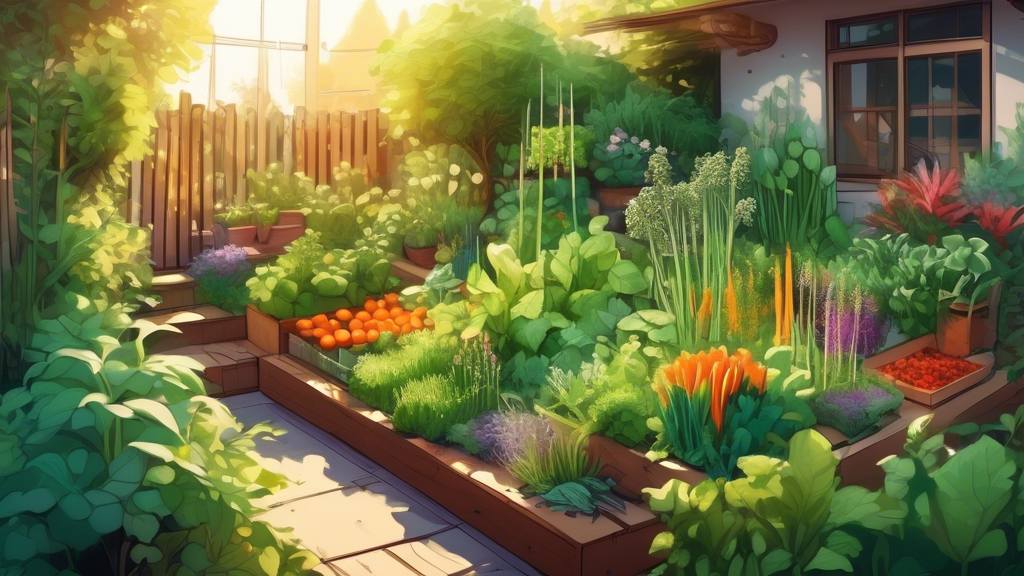Introduction
Space is a precious commodity for those with small gardens. But
limited square footage doesn’t have to mean limited harvests. Companion
planting, a time-tested gardening technique, allows you to maximize
your garden’s potential by strategically pairing plants that benefit
each other. This article delves into the intricacies of companion
planting, providing you with the knowledge to create a thriving,
abundant garden, no matter its size.
Understanding the Principles of Companion Planting
Companion planting, also known as intercropping or mixed planting,
goes beyond simply planting different species together. It’s about
understanding and harnessing the complex relationships between plants
to create a mutually beneficial environment. Here’s how it works:
1. Pest Control: Nature’s Own Defense Force
Some plants emit strong scents that deter common garden pests.
Planting these alongside more susceptible crops acts as a natural
deterrent, reducing the need for chemical pesticides.
2. Attracting Beneficial Insects: Inviting Nature’s Allies
Just as some plants repel harmful insects, others attract beneficial
ones. These beneficial insects, like ladybugs and lacewings, prey on
pests, providing natural pest control.
3. Improved Soil Health: Building a Strong Foundation
Different plants have different nutrient requirements and root
structures. Planting deep-rooted crops alongside shallow-rooted ones
improves soil structure, aeration, and nutrient availability.
4. Maximizing Space: Growing Up, Not Out
Companion planting allows you to utilize vertical space effectively.
By pairing plants with different growth habits, such as tall corn
stalks with vining beans, you can grow more in less space.
5. Enhanced Flavor: Taste the Difference
Surprisingly, some plant pairings can even enhance the flavor of
your crops. For example, planting basil alongside tomatoes is known to
improve the flavor of both.
Choosing the Right Companions: A Match Made in the Garden
Not all plant combinations are created equal. Some pairings are
classic for a reason, while others can actually hinder growth. Here’s
a closer look at some of the best companion plants for small gardens:
The Three Sisters: A Timeless Trio
This classic companion planting technique, originating from
indigenous cultures in North America, perfectly embodies the
principles of synergy. The Three Sisters are:
-
Corn: Provides sturdy support for the beans to
climb. -
Beans: Fix nitrogen in the soil, benefiting
the corn. -
Squash: Its large leaves provide shade,
suppressing weeds and retaining soil moisture.
Tomatoes and Basil: A Flavorful Partnership
Tomatoes and basil are not just culinary companions, they thrive
together in the garden too. Basil repels tomato hornworms, whiteflies,
and aphids, while also enhancing the flavor of tomatoes.
Carrots and Onions: Keeping Pests at Bay
Carrots and onions are another classic pairing that deters pests.
Onions deter carrot root flies, while carrots deter onion flies,
creating a mutually beneficial partnership.
Lettuce and Marigolds: Beauty and Protection
Marigolds are a gardener’s best friend, repelling a wide range of
pests. Planting them alongside lettuce protects the leafy greens from
aphids, whiteflies, and other common pests.
Cucumbers and Nasturtiums: A Trap Crop Strategy
Nasturtiums act as a trap crop, attracting pests like aphids and
cucumber beetles away from the cucumbers. This protects your cucumbers
while adding a splash of color to your garden.
Avoiding Bad Companions: Preventing Garden Conflicts
While many plant pairings are beneficial, some combinations can have
negative effects. These bad companions can compete for nutrients,
attract pests, or even inhibit each other’s growth. Here are some
pairings to avoid:
-
Tomatoes and Potatoes: Both are susceptible to
early blight and late blight, which can spread easily between them. -
Onions and Beans: Onions inhibit the growth
of beans, and beans can attract pests that harm onions. -
Mint and Anything: Mint is highly invasive
and can quickly take over your garden, crowding out other plants.
Planning Your Companion Planting Strategy
Successfully implementing companion planting in a small garden
requires careful planning. Here’s a step-by-step guide:
1. Assess Your Space:
Measure your garden bed and sketch out the layout. Consider the
amount of sunlight each area receives.
2. Choose Your Crops:
Select crops that you enjoy eating and that are well-suited to your
climate and growing season.
3. Research Compatible Companions:
Use the pairings listed above as a starting point and research
additional companion plants for your chosen crops.
4. Plan Your Planting Schedule:
Consider the staggered maturity dates of different plants. Planting
fast-growing crops alongside slower-growing ones ensures efficient
use of space.
5. Monitor and Adjust:
Observe your garden regularly and make adjustments as needed. Not all
companion planting strategies work perfectly in every environment, so
be prepared to experiment and learn what works best in your garden.
Conclusion
Companion planting is more than just a gardening technique; it’s a
way of thinking about your garden as an interconnected ecosystem. By
understanding the relationships between plants, you can create a
thriving, productive garden, no matter how small your space. Embrace
the principles of companion planting and watch your garden flourish.


